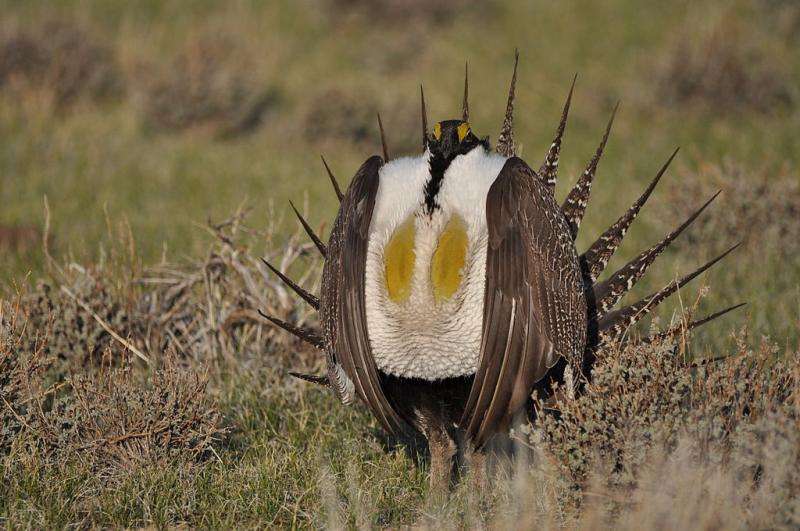California sage-grouse remain genetically diverse... for now

Genetic diversity is essential for a species to be able to adapt to environmental change, and when habitat loss divides a population into small, isolated fragments, that can spell trouble. Northeastern California is at the far western end of the range of Greater Sage-Grouse (Centrocercus urophasianus), and the fringe population there is declining due to the ongoing invasion of their sagebrush habitat by cheatgrass and juniper. To determine whether the genetic diversity of birds in the region is suffering as a result, Dawn Davis of the University of Idaho and her colleagues spent three years collecting blood samples from California sage-grouse on their breeding grounds for a new study forthcoming in The Condor: Ornithological Applications.
While they found no evidence that individual leks, or breeding sites, in California are genetically isolated from each other, and the overall genetic diversity of the California population was just as high as that in the core of the species' range. However, this doesn't mean that the future of these vulnerable birds is secure.
Every spring, sage-grouse gather at breeding sites called leks, where males put on elaborate displays to attract females. Davis and her colleagues collected blood from 167 grouse at 13 lek sites between 2007 and 2009.Their results suggest that there is a continuing exchange of genes between California leks, and possibly even with the adjacent Nevada population. "Sage-grouse occupy the western edge of their distribution in northeastern California and our study area was dominated by invasive annual grasses and encroaching conifer which has led to declines in sage-grouse populations," explains Davis. "Our study found that despite population declines and habitat loss, leks were not genetically differentiated, which was unexpected."
This may sound like good news, but it doesn't mean we can stop worrying about California's sage-grouse population. In a species where dispersal, the movement of individuals between breeding areas is limited, it can take several generations for effects of habitat fragmentation on genetic diversity to be detectable, and in the meantime the amount of suitable habitat in California continues to shrink.
"Although our results suggest that sage-grouse have tolerated some degree of habitat fragmentation without losing genetic diversity, continued habitat loss and deterioration will likely result in additional declines in this population," says Davis. "From a management perspective, we suggest that maintaining and improving habitat quality and connectivity of sage-grouse habitats in northeastern California will be critical for maintaining gene flow and will be necessary to sustain sage-grouse in northeastern California." This will mean knitting isolated population fragments back together, creating corridors of healthy sagebrush habitat so that dispersal can continue. Sage-grouse face an uncertain future throughout their range, and no one population or lek is expendable if these iconic western birds are going to continue to thrive.
More information: "Genetic structure of Greater Sage-Grouse (Centrocercus urophasianus) in a declining, peripheral population" will be available September 16, 2015 at www.aoucospubs.org/toc/cond/117/4
Provided by The Condor
















